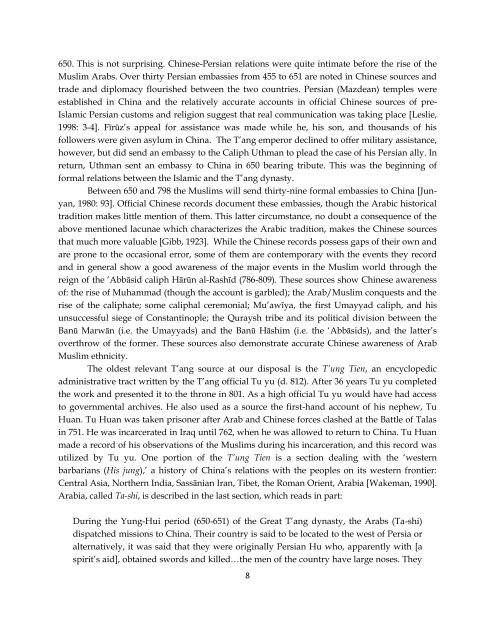Prophet Muhammad and the Black Arabs - Dr. Wesley Muhammad
Prophet Muhammad and the Black Arabs - Dr. Wesley Muhammad
Prophet Muhammad and the Black Arabs - Dr. Wesley Muhammad
You also want an ePaper? Increase the reach of your titles
YUMPU automatically turns print PDFs into web optimized ePapers that Google loves.
650. This is not surprising. Chinese-Persian relations were quite intimate before <strong>the</strong> rise of <strong>the</strong><br />
Muslim <strong>Arabs</strong>. Over thirty Persian embassies from 455 to 651 are noted in Chinese sources <strong>and</strong><br />
trade <strong>and</strong> diplomacy flourished between <strong>the</strong> two countries. Persian (Mazdean) temples were<br />
established in China <strong>and</strong> <strong>the</strong> relatively accurate accounts in official Chinese sources of pre-<br />
Islamic Persian customs <strong>and</strong> religion suggest that real communication was taking place [Leslie,<br />
1998: 3-4]. Fīrūz’s appeal for assistance was made while he, his son, <strong>and</strong> thous<strong>and</strong>s of his<br />
followers were given asylum in China. The T’ang emperor declined to offer military assistance,<br />
however, but did send an embassy to <strong>the</strong> Caliph Uthman to plead <strong>the</strong> case of his Persian ally. In<br />
return, Uthman sent an embassy to China in 650 bearing tribute. This was <strong>the</strong> beginning of<br />
formal relations between <strong>the</strong> Islamic <strong>and</strong> <strong>the</strong> T’ang dynasty.<br />
Between 650 <strong>and</strong> 798 <strong>the</strong> Muslims will send thirty-nine formal embassies to China [Junyan,<br />
1980: 93]. Official Chinese records document <strong>the</strong>se embassies, though <strong>the</strong> Arabic historical<br />
tradition makes little mention of <strong>the</strong>m. This latter circumstance, no doubt a consequence of <strong>the</strong><br />
above mentioned lacunae which characterizes <strong>the</strong> Arabic tradition, makes <strong>the</strong> Chinese sources<br />
that much more valuable [Gibb, 1923]. While <strong>the</strong> Chinese records possess gaps of <strong>the</strong>ir own <strong>and</strong><br />
are prone to <strong>the</strong> occasional error, some of <strong>the</strong>m are contemporary with <strong>the</strong> events <strong>the</strong>y record<br />
<strong>and</strong> in general show a good awareness of <strong>the</strong> major events in <strong>the</strong> Muslim world through <strong>the</strong><br />
reign of <strong>the</strong> ‘Abbāsid caliph Hārūn al-Rashīd (786-809). These sources show Chinese awareness<br />
of: <strong>the</strong> rise of <strong>Muhammad</strong> (though <strong>the</strong> account is garbled); <strong>the</strong> Arab/Muslim conquests <strong>and</strong> <strong>the</strong><br />
rise of <strong>the</strong> caliphate; some caliphal ceremonial; Mu’awīya, <strong>the</strong> first Umayyad caliph, <strong>and</strong> his<br />
unsuccessful siege of Constantinople; <strong>the</strong> Quraysh tribe <strong>and</strong> its political division between <strong>the</strong><br />
Banū Marwān (i.e. <strong>the</strong> Umayyads) <strong>and</strong> <strong>the</strong> Banū Hāshim (i.e. <strong>the</strong> ‘Abbāsids), <strong>and</strong> <strong>the</strong> latter’s<br />
overthrow of <strong>the</strong> former. These sources also demonstrate accurate Chinese awareness of Arab<br />
Muslim ethnicity.<br />
The oldest relevant T’ang source at our disposal is <strong>the</strong> T’ung Tien, an encyclopedic<br />
administrative tract written by <strong>the</strong> T’ang official Tu yu (d. 812). After 36 years Tu yu completed<br />
<strong>the</strong> work <strong>and</strong> presented it to <strong>the</strong> throne in 801. As a high official Tu yu would have had access<br />
to governmental archives. He also used as a source <strong>the</strong> first-h<strong>and</strong> account of his nephew, Tu<br />
Huan. Tu Huan was taken prisoner after Arab <strong>and</strong> Chinese forces clashed at <strong>the</strong> Battle of Talas<br />
in 751. He was incarcerated in Iraq until 762, when he was allowed to return to China. Tu Huan<br />
made a record of his observations of <strong>the</strong> Muslims during his incarceration, <strong>and</strong> this record was<br />
utilized by Tu yu. One portion of <strong>the</strong> T’ung Tien is a section dealing with <strong>the</strong> ‘western<br />
barbarians (His jung),’ a history of China’s relations with <strong>the</strong> peoples on its western frontier:<br />
Central Asia, Nor<strong>the</strong>rn India, Sassānian Iran, Tibet, <strong>the</strong> Roman Orient, Arabia [Wakeman, 1990].<br />
Arabia, called Ta-shi, is described in <strong>the</strong> last section, which reads in part:<br />
During <strong>the</strong> Yung-Hui period (650-651) of <strong>the</strong> Great T’ang dynasty, <strong>the</strong> <strong>Arabs</strong> (Ta-shi)<br />
dispatched missions to China. Their country is said to be located to <strong>the</strong> west of Persia or<br />
alternatively, it was said that <strong>the</strong>y were originally Persian Hu who, apparently with [a<br />
spirit’s aid], obtained swords <strong>and</strong> killed…<strong>the</strong> men of <strong>the</strong> country have large noses. They<br />
8
















